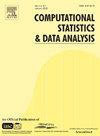用非线性局部平均场近似推断准反应系统的动力学
IF 1.6
3区 数学
Q3 COMPUTER SCIENCE, INTERDISCIPLINARY APPLICATIONS
引用次数: 0
摘要
随机准反应系统中动力学速率的参数估计具有挑战性,特别是当连续测量之间的时间间隔较大时。局部线性逼近方法解释了系统的随机性,但未能捕捉到过程平均动力学的内在非线性性质。此外,准反应系统的平均动力学可以用ode系统来描述,而ode系统只有对简单酉系统才有显式解。通过危险率的一阶泰勒近似,导出了一般准反应系统的近似解析解。这允许在给定系统当前状态下对未来动态进行非线性前向预测。预测和相应的观测嵌入在参数估计的非线性最小二乘方法中。通过仿真研究,将该算法的性能与现有方法进行了比较。结果表明,该方法在准反应体系的描述中具有通用性,计算效率有所提高,在动力学速率估计方面也有改进,特别是在大时间间隔观测数据时。此外,显式解的可用性使该方法对刚度具有鲁棒性,这通常存在于生物系统中。恒河猴数据的应用说明了该方法在细胞分化研究中的应用。本文章由计算机程序翻译,如有差异,请以英文原文为准。
Inferring the dynamics of quasi-reaction systems via nonlinear local mean-field approximations
Parameter estimation of kinetic rates in stochastic quasi-reaction systems can be challenging, particularly when the time gap between consecutive measurements is large. Local linear approximation approaches account for the stochasticity in the system but fail to capture the intrinsically nonlinear nature of the mean dynamics of the process. Moreover, the mean dynamics of a quasi-reaction system can be described by a system of ODEs, which have an explicit solution only for simple unitary systems. An approximate analytical solution is derived for generic quasi-reaction systems via a first-order Taylor approximation of the hazard rate. This allows a nonlinear forward prediction of the future dynamics given the current state of the system. Predictions and corresponding observations are embedded in a nonlinear least-squares approach for parameter estimation. The performance of the algorithm is compared to existing methods via a simulation study. Besides the generality of the approach in the specification of the quasi-reaction system and the gains in computational efficiency, the results show an improvement in the kinetic rate estimation, particularly for data observed at large time intervals. Additionally, the availability of an explicit solution makes the method robust to stiffness, which is often present in biological systems. Application to Rhesus Macaque data illustrates the use of the method in the study of cell differentiation.
求助全文
通过发布文献求助,成功后即可免费获取论文全文。
去求助
来源期刊

Computational Statistics & Data Analysis
数学-计算机:跨学科应用
CiteScore
3.70
自引率
5.60%
发文量
167
审稿时长
60 days
期刊介绍:
Computational Statistics and Data Analysis (CSDA), an Official Publication of the network Computational and Methodological Statistics (CMStatistics) and of the International Association for Statistical Computing (IASC), is an international journal dedicated to the dissemination of methodological research and applications in the areas of computational statistics and data analysis. The journal consists of four refereed sections which are divided into the following subject areas:
I) Computational Statistics - Manuscripts dealing with: 1) the explicit impact of computers on statistical methodology (e.g., Bayesian computing, bioinformatics,computer graphics, computer intensive inferential methods, data exploration, data mining, expert systems, heuristics, knowledge based systems, machine learning, neural networks, numerical and optimization methods, parallel computing, statistical databases, statistical systems), and 2) the development, evaluation and validation of statistical software and algorithms. Software and algorithms can be submitted with manuscripts and will be stored together with the online article.
II) Statistical Methodology for Data Analysis - Manuscripts dealing with novel and original data analytical strategies and methodologies applied in biostatistics (design and analytic methods for clinical trials, epidemiological studies, statistical genetics, or genetic/environmental interactions), chemometrics, classification, data exploration, density estimation, design of experiments, environmetrics, education, image analysis, marketing, model free data exploration, pattern recognition, psychometrics, statistical physics, image processing, robust procedures.
[...]
III) Special Applications - [...]
IV) Annals of Statistical Data Science [...]
 求助内容:
求助内容: 应助结果提醒方式:
应助结果提醒方式:


